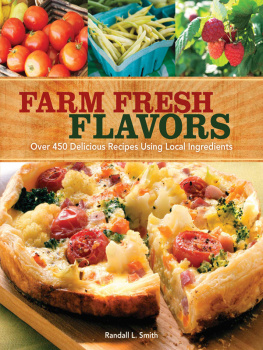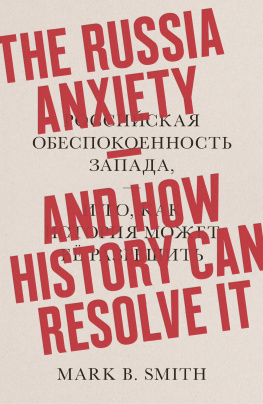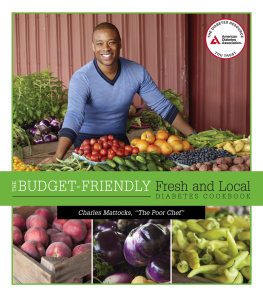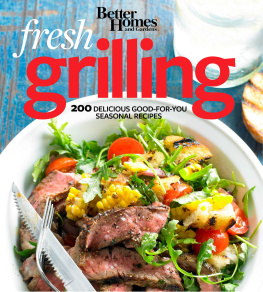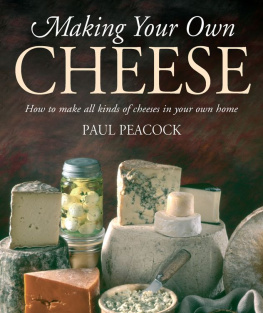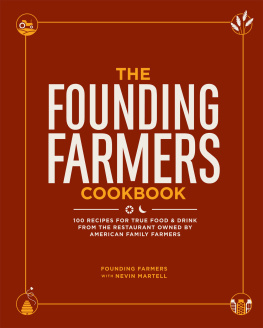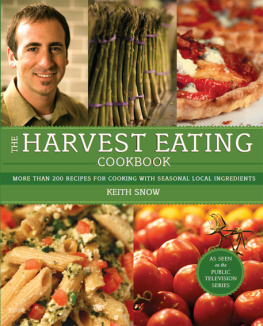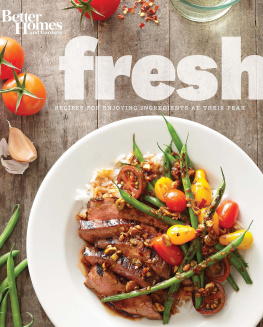FARM FRESH
FLAVORS
Over 450 Delicious Recipes Using Local Ingredients
Randall L. Smith

FARM FRESH FLAVORS Copyright 2011 by Randall L. Smith. Manufactured in China. All rights reserved. No part of this book may be reproduced in any form or by any electronic or mechanical means including information storage and retrieval systems without permission in writing from the publisher, except by a reviewer who may quote brief passages in a review. The content of this book has been thoroughly reviewed for accuracy. However, the author and publisher disclaim any liability for any damages, losses, or injuries that may result from the use or misuse of any product or information presented herein. It is the purchaser's responsibility to read and follow all instructions and warnings on all product labels. Published by Betterway Home Books, an imprint of F+W Media, Inc., 4700 East Galbraith Road, Cincinnati, Ohio, 45236. (800) 289-0963. First Edition.

Other fine Betterway Home Books are available from your local bookstore, online, or direct from the publisher. Visit our website, www.betterwaybooks.com.
15 14 13 12 11 5 4 3 2 1
eISBN 13: 978-1-4403-1522-0
Distributed in Canada by Fraser Direct
100 Armstrong Avenue, Georgetown, Ontario, Canada L7G 5S4, Tel: (905) 877-4411
Distributed in the U.K. and Europe by F+W Media International
Brunel House, Newton Abbot, Devon, TQ12 4PU, England, Tel: (+44) 1626 323200, Fax: (+44) 1626 323319, E-mail: postmaster@davidandcharles.co.uk
Distributed in Australia by Capricorn Link
P.O. Box 704, S. Windsor NSW, 2756 Australia, Tel: (02) 4577-3555
Edited by Candy Wiza
Cover designed by Clare Finney
Interior designed by Hotiron Creative
Production coordinated by Mark Griffin
For Heidi
INTRODUCTION
A fter twenty years cooking professionally, I am always amazed at the reluctance of most people to cook; I started cooking to make some beer money in college. If a hopelessly lazy young man can do it, I know the ambitious and enlightened readers of this book can as well.
This is a cookbook and, as such, it is simply a how-to on using fresh ingredients with a little flair. Most of the recipes can be prepared with tools that most of us have in our kitchens and with ingredients easily found in any neighborhood. I have tried to explain any ingredients that are unusual and give directions on how to find them. The main ingredients are the items you get from your local farmers, CSA share or your own backyard and these are the centerpieces of the book. I have consciously tried to keep the instructions light and not weighted down with formulas and rigid chemistry. I have steered away from recipes with a lot of moving parts and long lists of ingredients. The point of the book is to make eating fresh food simple so that you will choose it over the processed trinkets found on store shelves.
A couple of things this book is not: It is not a handbook on nutrition; any reference to nutritive value is purely accidental. If you eat a wide variety of fresh food and avoid processed food, the amount and types of nutrients you get should take care of itself. It also is not a chemistry textbook. Nearly every ingredient has an alternative, and learning to be flexible with those ingredients is part of learning to cook. The best recipe is just a starting point for you to experiment. Please change anything you want according to taste. It is also not a screed for vegetarianism, but it is loaded with primarily vegetarian recipes. I'll let the reader investigate independently the thousand reasons we should eat more plant-based food. I don't want to preach but I became a vegetarian during the writing of this book. Take that for what it is worth.
Acknowledgments
This book would not have been possible without the help of Candy Wiza who shepherded me through an unfamiliar and arduous process and Pamela MacDonald who was a much needed second set of eyes. Both of these women have as much ownership as I do in this book. I thank them sincerely.
Eating fresh seasonal products from someone you know brings a little magic. A weekly CSA box, a trip to the farmers market or a few steps to your backyard garden filled with items that are constantly arriving, departing, changing and offering up their wonders will require focus and attention. It will demand that you treat two of the more important activities of your life, cooking and eating, with respect. It will help you take yourself more seriously and install meaning in what has become a meaningless exercise take-out is so much easier. Bringing meaning to your life is the only real reason to do anything. If we eat food grown by men and women we respect, make love to those we love and do work that doesn't require compromise, we can't help but have full, meaningful and important lives. My wish is that this book, in some small way brings you closer to that goal.
And you thought it was just dinner!
Randy Smith
1
LOCAL RESOURCES
T here is a movement afoot to develop a more personal relationship with food. A small but vocal minority has shouted hell no to the anonymous bread mill that delivers our daily bread. Many are concerned about the environmental degradation that institutional farming and food processing engender. The endless monocultures of chemically sustained corn and soybeans that carpet Middle America leaves our soils barren and require enormous petroleum inputs to sustain. Vast feedlots of cattle, hogs and chickens produce mountains of manure that pollute our waterways and groundwater.
Some are concerned about the questionable wholesomeness of the Western diet with nutrients processed out and complex and sometimes dangerous chemicals processed in. The Western diet has largely been reduced to various combinations of corn, soybeans and chemicals.
The welfare of factory-farmed and processed animals is also troubling, including the unseen cruelty they endure in order to be brought to our table. Cattle, hogs and chickens are confined in teeming enclosures and force-fed unnatural diets. These practices cannot be sustained and enlightened people are looking for alternatives. They are seeking a more intimate and significant relationship to the food we eat and the universe that produces that food. We have attempted to co-opt natural rhythms with science and need to return to sustainable consumption searching for a way to balance our food karma. A way of eating that allows us to join in a timeless cycle of natural renewal and to participate rather than exploit.
Part of finding a more connected way to cook and eat is dealing with abundance when you are blessed with it and scarcity when nature demands it. The traditional coming and going of scarcity and abundance linked us with timeless rhythms of nature, the earth and ourselves. We had to think and plan ahead. We had to treasure and conserve the abundance. We had to manage and endure scarcity. We had to take what the world gave us and it taught us discipline, reverence and humility. These lessons are harder to come by when we can get anything we want, anytime we want, already prepared, for a few bucks and a small amount of time. I think this convenience and plenitude has made our lives less interesting. We all eat the same things and we eat them all year long. We follow the same diets and talk about food in the same ways. We aren't forced to change our tastes at all. It is entirely possible and, way too common, for a person to eat the same breakfasts every morning, every day of their life. We eat Hot Pockets and microwave dinners and the same frozen vegetable blends in December, June and October. We don't cook anything fresh because that would require understanding and commitment; understanding what we were meant to eat at any given season of the year and commitment to using that food with good sense and integrity.

